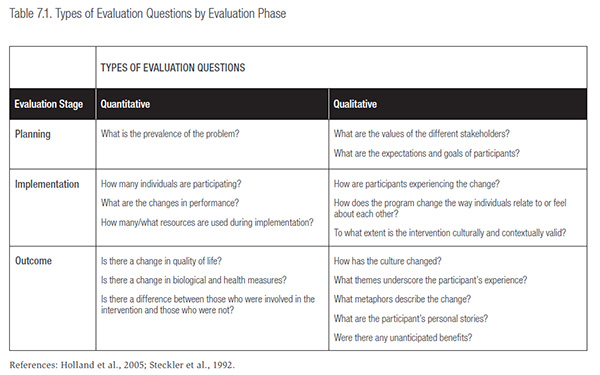Approaches to Evaluation
Two approaches are particularly useful when framing an evaluation of community engagement programs; both engage stakeholders. In one, the emphasis is on the importance of participation; in the other, it is on empowerment. The first approach, participatory evaluation, actively engages the community in all stages of the evaluation process. The second approach, empowerment evaluation, helps to equip program personnel with the necessary skills to conduct their own evaluation and ensure that the program runs effectively. This section describes the purposes and characteristics of the two approaches.
Participatory Evaluation
Participatory evaluation can help improve program performance by (1) involving key stakeholders in evaluation design and decision making, (2) acknowledging and addressing asymmetrical levels of power and voice among stakeholders, (3) using multiple and varied methods, (4) having an action component so that evaluation findings are useful to the program’s end users, and (5) explicitly aiming to build the evaluation capacity of stakeholders (Burke, 1998).
- The focus is on participant ownership; the evaluation is oriented to the needs of the program stakeholders rather than the funding agency.
- Participants meet to communicate and negotiate to reach a consensus on evaluation results, solve problems, and make plans to improve the program.
- Input is sought and recognized from all participants.
- The emphasis is on identifying lessons learned to help improve program implementation and determine whether targets were met.
- The evaluation design is flexible and determined (to the extent possible) during the group processes.
- The evaluation is based on empirical data to determine what happened and why.
- Stakeholders may conduct the evaluation with an outside expert serving as a facilitator.
Empowerment Evaluation
Empowerment evaluation is an approach to help ensure program success by providing stakeholders with tools and skills to evaluate their program and ensuring that the evaluation is part of the planning and management of the program (Fetterman, 2008). The major goal of empowerment evaluation is to transfer evaluation activities from an external evaluator to the stakeholders. Empowerment evaluation has four steps: (1) taking stock of the program and determining where it stands, including its strengths and weaknesses; (2) establishing goals for the future with an explicit emphasis on program improvement; (3) developing strategies to help participants determine their own strengths that they can use to accomplish program goals and activities; and (4) helping program participants decide on and gather the evidence needed to document progress toward achieving their goals (Fetterman, 1994).
- Values improvement in people, programs, and organizations to help them achieve results.
- Community ownership of the design and conduct of the evaluation and implementation of the findings.
- Inclusion of appropriate participants from all levels of the program, funders, and community.
- Democratic participation and clear and open evaluation plans and methods.
- Commitment to social justice and a fair allocation of resources, opportunities, obligations, and bargaining power.
- Use of community knowledge to understand the local context and to interpret results.
- Use of evidence-based strategies with adaptations to the local environment and culture.
- Building the capacity of program staff and participants to improve their ability to conduct their own evaluations.
- Organizational learning, ensuring that programs are responsive to changes and challenges.
- Accountability to funders’ expectations.
The potential disadvantages of participatory and empowerment evaluation include (1) the possibility that the evaluation will be viewed as less objective because of stakeholder involvement, (2) difficulties in addressing highly technical aspects, (3) the need for time and resources when involving an array of stakeholders, and (4) domination and misuse by some stakeholders to further their own interests. However, the benefits of fully engaging stakeholders throughout the evaluation outweigh these concerns (Fetterman et al., 1996).

